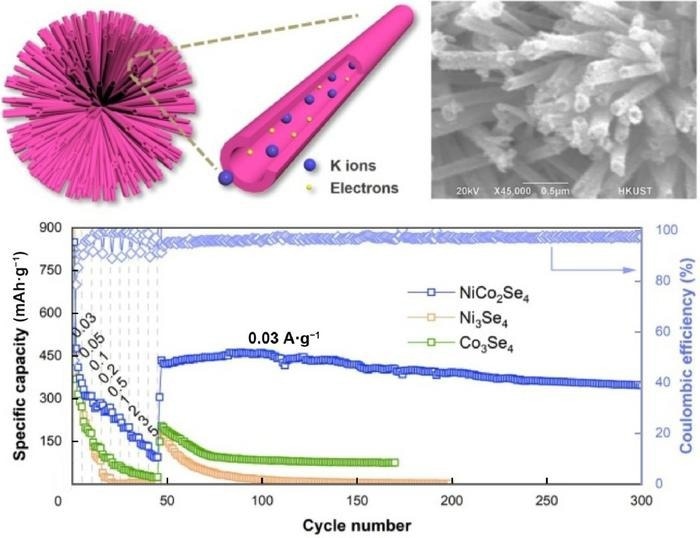Scientists searching for lithium-ion battery substitutes have shifted their focus to potassium-ion batteries. Although potassium is an abundant material and the technology works similarly to lithium-ion batteries, these batteries have not been explored extensively because of issues with energy storage and poor electrochemical performance caused by the ionic radius.
 This graphic includes a diagram showing the structure of NiCo2Se4 nanotube spheres that have been used to create anodes for potassium-ion batteries. It also includes a graph showing the improved performance of the potassium-ion batteries constructed with the NiCo2Se4 nanotube spheres. Image Credit: Energy Materials and Devices, Tsinghua University Press
This graphic includes a diagram showing the structure of NiCo2Se4 nanotube spheres that have been used to create anodes for potassium-ion batteries. It also includes a graph showing the improved performance of the potassium-ion batteries constructed with the NiCo2Se4 nanotube spheres. Image Credit: Energy Materials and Devices, Tsinghua University Press
Researchers are considering the bimetallic selenide NiCo2Se4 as a solution to this issue to make electrodes in the shape of spheres. Using NiCo2Se4 nanotubes to construct the device's spheres enhances their electrochemical reactivity, facilitating faster potassium ion transport and storage.
The findings were published in Energy Materials and Devices on September 14th, 2023.
Bimetallic selenides combine the ameliorating features of two metals, which synergize by showing rich redox reaction sites and high electrochemical activities. One bimetallic selenide, NiCo2Se4, was previously studied for sodium storage, supercapacitors, and electrocatalysts and presents considerable potential for potassium ion storage.
Mingyue Wang, Researcher, Engineering Research Center of Energy Storage Materials and Devices, Xi’an Jiaotong University
Wang continues, "By synthesizing NiCo2Se4 using a two-step hydrothermal process, a nanotube structure with flower-like clusters develops, creating convenient channels for potassium ion/electron transfer.."
Initially, solid nanoneedle Ni-Co precursor spheres are developed. During a procedure known as selenium exposure, the distinct crystalline structure of these spheres is exposed to selenium. By adding selenium to the Ni-Co precursor, this method creates the NiCo2Se4 nanotube shell.
The Kirkendall effect, which occurs when two metals move due to differences in the diffusion rates of their atoms, is the reason for the hollow tubes. With a width of about 35 nanometers, these nanotubes provide adequate room for the transport of electrons and potassium ions.
The researchers were able to verify the NiCo2Se4 anodes’ ability to transport and store potassium ions and electrons using a range of experiments and analyses. They discovered that NiCo2Se4 outperformed other electrodes tested during the study and had more active sites and evenly distributed components than other electrode materials.
Wang added, “The NiCo2Se4 nanotube electrode presented a much better electrochemical performance in terms of cyclic stability and rate capability than other tested electrodes, including Ni3Se4 and Co3Se4. This is because of the unique nanotube structure of NiCo2Se4 and the synergy offered by the co-presence of two metals.”
Because of the way the two metals (Ni and Co) interact together, the monometallic counterparts, Ni3Se4 and Co3Se4, were not as successful as the bimetallic NiCo2Se4. NiCo2Se4 also exhibited a larger capacity, which is particularly important for cyclic stability and high-rate performance.
This work offers new insights into the design of micro/nano-structured binary metal selenides as anodes for potassium-ion batteries with extraordinary potassium ion storage performance.
Mingyue Wang, Researcher, Engineering Research Center of Energy Storage Materials and Devices, Xi’an Jiaotong University
Yang Li, Shanshan Yao, Jiang Cui, Lianbo Ma, Nauman Mubarak, Hongming Zhang, and Jang-Kyo Kim from the Department of Mechanical and Aerospace Engineering at the Hong Kong University of Science and Technology; and Shujiang Ding at the Engineering Research Center of Energy Storage Materials and Devices at Xi’an Jiaotong University are the other study contributors.
This study was funded by the Research Grants Council, the Innovation and Technology Commission of Hong Kong SAR, and the National Natural Science Foundation of China.
Journal Reference:
Wang, M., et al. (2023) Conversion mechanism of NiCo2Se4 nanotube sphere anodes for potassium-ion batteries. Energy Materials and Devices. doi:10.26599/EMD.2023.9370001